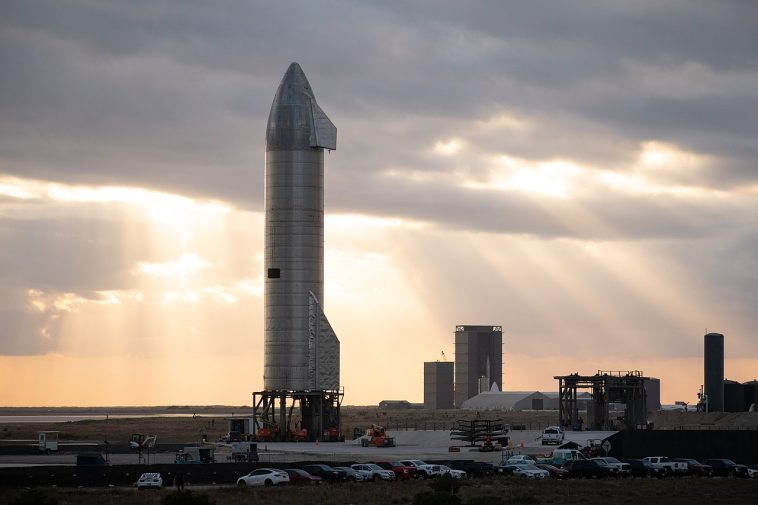Another entry into my blog series on countering misconceptions in space journalism. I discussed this post on The Space Show on November 5 2021.
It has been exactly two years since my initial posts on Starship and Starlink. While the Starlink post has aged quite well, Starship is still not widely understood despite intervening developments. As usual, this blog represents my own opinions and I do not have any inside information.
There is now an audio version of this blog.
[Update Oct 2023: Ars reports that senior JPL and NASA observatory advocates have testified that Starship’s capabilities must be exploited for next generation telescope design.]
To catch you up, two years ago SpaceX unveiled their boilerplate full scale mockup of Starship. Starhopper had completed two untethered flights. SN5 and SN6 hopped to 150 m in August and September of 2020, followed by 10-12 km flights of SN8, SN9, SN10, SN11, and SN15 between December 2020 and May 2021, the last of which stuck the landing.
Two years ago, Raptor was unproven, aero flaps had never been demonstrated, and stainless steel rocket construction was still troubled. Today, these major programmatic risks are largely retired. SpaceX has qualified their full flow staged combustion engine. They’ve done a full system test of the landing process, and they’ve ramped up QA in construction. There are still major risks on the critical path between now and a fully reusable Starship, but no miracles are required to solve them. For example, many mature heat shield (TPS) designs already exist. SpaceX can try to make a better, cheaper, lighter one but if it doesn’t work out, they can always trade some mass and just use PICA, like Dragon. In just two years, practically all the low TRL science projects have been solved.
SN9 on the pad (wikimedia).
As of late October 2021, SN20 and the booster SB4 have performed basic fit checks and individual static fires, while the ground support equipment and the launch tower are being assembled with truly gigantic cranes. The Boca Chica rocket factory and launch site are now enormous ongoing operations, as seen in this video tour with Tim Dodd, the Everyday Astronaut.
While I am 100% certain that the Starship design will continue to evolve in noticeable ways, the progress in two years cannot be understated. Two years ago Starship was a design concept and a mock up. Today it’s a 95% complete prototype that will soon fly to space and may even make it back in one piece.
The odds of Starship actually working in the near future are much higher today than they were two years ago. Across the industry, decisions are being made on a time horizon in which Starship operation is relevant, and yet it is not being correctly accounted for.
Starship matters. It’s not just a really big rocket, like any other rocket on steroids. It’s a continuing and dedicated attempt to achieve the “Holy Grail” of rocketry, a fully and rapidly reusable orbital class rocket that can be mass manufactured. It is intended to enable a conveyor belt logistical capacity to Low Earth Orbit (LEO) comparable to the Berlin Airlift. That is, Starship is a powerful logistical system that puts launch below the API.
Starship is designed to be able to launch bulk cargo into LEO in >100 T chunks for 100 T of bulk cargo anywhere in the solar system, including the surface of the Moon or Mars, for $1,000,000/kg for deep space exploration.
Enter Starship. Annual capacity to LEO climbs from its current average of 500 T for the whole of our civilization to perhaps 500 T per week. Eventually, it could exceed 1,000,000 T/year. At the same time, launch costs drop as low as $50/kg, roughly 100x lower than the present. For the same budget in launch, supply will have increased by roughly 100x. How can the space industry saturate this increased launch supply?
I doubt Congress is going to increase NASA’s budget to a trillion dollars, so NASA and industry will have to find a way to produce 100x as much stuff for 1/10th the price. Rovers will have to be $1000/kg and we will need 100 T of them every year. This is comparable in terms of costs and volumes to Ferrari manufacturing, so we’re not necessarily talking about replicating Toyota’s automated production lines, but we are definitely talking about finding ways to drastically increase the productivity of the current work force, while shifting its skill focus away from mass optimization and towards mass generation. Since the mass constraint really doesn’t matter anymore, there isn’t much point devoting hundreds of person-years of effort into assembling the whole thing from custom machined titanium parts.
This is where the risk to the space industry originates. Prior to Starship, heavy machinery for building a Moon base could only come from NASA, because only NASA has the expertise to build a rocket propelled titanium Moon tractor for a billion dollars per unit. After Starship, Caterpillar or Deere or Kamaz can space qualify their existing commodity products with very minimal changes and operate them in space. In all seriousness, some huge Caterpillar mining truck is already extremely rugged and mechanically reliable. McMaster-Carr already stocks thousands of parts that will work in mines, on oil rigs, and any number of other horrendously corrosive, warranty voiding environments compared to which the vacuum of space is delightfully benign. A space-adapted tractor needs better paint, a vacuum compatible hydraulic power source, vacuum-rated bearings, lubricants, wire insulation, and a redundant remote control sensor kit. I can see NASA partnering with industry to produce and test these parts, but that is no way to service the institutional overhead embodied by a team of hundreds of people toiling on a single mission for a decade. There is a reason that JPL’s business depends on a steady stream of directed flagship missions with billion dollar price tags. Hordes of PhDs don’t come cheap and need a lot of care and feeding.
Even if the space industry fully understood Starship, I think it would be very difficult for them to plan and adapt rapidly enough to match the coming explosion in launch capacity. But it has been two years since my earlier post and the implications were obvious enough even then. Yet I have seen almost no evidence that, on an organizational level, any of the prime contractors or senior NASA leadership have internalized the full implications of the coming change.
History is littered with the wreckage of former industrial titans that underestimated the impact of new technology and overestimated their ability to adapt. Blockbuster, Motorola, Kodak, Nokia, RIM, Xerox, Yahoo, IBM, Atari, Sears, Hitachi, Polaroid, Toshiba, HP, Palm, Sony, PanAm, Sega, Netscape, Compaq, Enron, GM, DeLorean, Nortel. In many cases, such as with Kodak and digital cameras, these powerful corporations even invented the technology that eventually destroyed them. It was not a surprise. Everyone saw it coming. But senior management failed to recognize that adaptation would require stepping beyond the accepted bounds of their traditional business practice. Starship, like Falcon, is built on a foundation of fundamental rocketry research funded and performed by NASA, Roscosmos, and other government agencies. SpaceX has found a powerful new synthesis but they didn’t invent rockets from scratch. Either the incumbent space industry adapts to Starship by finding ways to produce much more space hardware for much lower cost, or dozens of other new companies, unbound by tradition, entrenched interests, and high organizational overhead, will permanently take their business.
Just two weeks ago, former NASA Associate Administrator for Exploration and current Boeing consultant Doug Cooke, gave a presentation on his vision for lunar exploration, as reported by Jeff Foust.
Doug Cooke’s slide on Lunar Exploration Oct 12 2021 (Jeff Foust).
The washed out yellow on black can be hard to read, so I’ll copy the text below [grammatical errors and typos uncorrected].
Logical Early Lunar Architecture and Mission(s)
Architecture
130 mt SLS (Block 2) as envisioned in the 2010 Authorization Act.
Orion as presently configured.
Develop two-stage, storable propellant lunar lander with not-to-exceed mass of 33 mT.
Lander requirements – include cargo mode to land hab(s), rovers, surface infrastructure – separate from crew landings.
Develop Lunar Orbit Injection (LOI) stage capable of delivering the lander to Low Lunar Orbit (LLO) using efficient Liquid Oxygen/Hydrogen fuel. Same LOI stage design for delivering Orion and service module to LLO.
Enhance Ground Systems to support this architecture with sufficient flight rate.
Lunar Mission
Fully fueled integrated lander is launched as cargo on the SLS Block 2 and injected by the LOI stage into LLO to await the crew.
Crew is launched on SLS to LLO in Orion using the same LOI stage design as for the lander.
Several tons of margin for additional cargo
Orion performs the rendezvous with the lander in LLO
Crew and additional equipment and provisions transfer to the ascent stage on the lander.
With the crew onboard, the lander descends from LLO and lands on the lunar surface.
The crew executes its surface mission
The crew launches back to LLO in the ascent stage to rendezvous and transfer to Orion.
The crew returns to Earth from LLO in Orion, using the Orion Service Module to perform the Trans-Earth Insertion (TEI) maneuver.
Follow-on Crew and Cargo Missions to fulfill lunar exploration objectives
Allow me to fill in the gaps. This is 98% similar to the original Constellation lunar program. It requires SLS Block 2, which has a new, upgraded upper stage. This was always meant to be part of Ares V and it’s what has always been required to make SLS actually useful, with real cargo capacity to LEO and beyond. Of course, this Exploration Upper Stage (EUS) is still in the preliminary design phase and may never actually be built let alone flown. In addition to the EUS, which is essentially a whole new rocket, this architecture also requires a Lunar Insertion Stage, also originally called for in the Constellation architecture but long since cancelled, and without which Orion can’t even make it to Low Lunar Orbit (LLO). It also requires a new two stage lander, which is still being treated almost as an afterthought.
When it’s all put together, we have an architecture rather similar to Apollo, only heavier, more expensive, slower, with more moving parts, and with about the same net cargo capacity to the surface. That is, another decade or so of incredibly expensive clean sheet development of four new space vehicles, and for what? The ability to get “several tonnes” of marginal cargo to the surface for two launches of the SLS Block 2, and to finally deliver the Lunar part of Constellation two decades late and at ten times the price, as though it was never justifiably cancelled in the first place?
Consider the two critical metrics: Dollars per tonne ($/T) and tonnes per year (T/year). Any effective space transport cargo logistics system must aggressively optimize both these metrics simultaneously. Starship is intended to reach numbers as low as $1m/T and 1000 T/year for cargo soft landed on the Moon. Apollo achieved about $2b/T and 2 T/year for cargo soft landed on the Moon. Constellation 2.0 as described above would be more like $4b/T and 2 T/year.
Not only is this architecture obviously worse than Starship, it’s also significantly worse than Apollo or any existing lunar delivery system. For example, the Blue Moon lander could be flown on Falcon Heavy, delivering perhaps 10 T to the surface for



GIPHY App Key not set. Please check settings